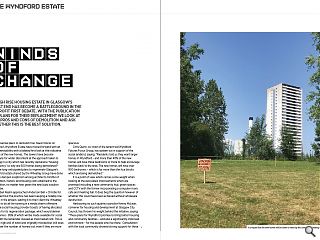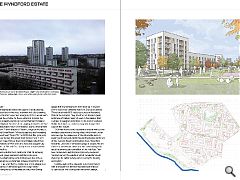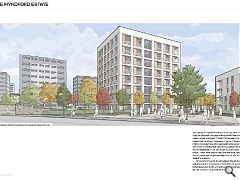The Wyndford: Winding Down
7 May 2024
A high rise housing estate in Glasgow’s West End has become a battleground in the retrofit first debate. With the publication of plans for their replacement we look at the pros and cons of demolition and ask whether this is the best solution.
Controversial plans to demolish four tower blocks on Glasgow’s Wyndford Estate have moved forward with an air of inevitability with a belated first look at the indicative design of the new homes. The towers have become talismans for wider discontent at the approach taken to housing in a city which has recently declared a ‘housing emergency’ so why are 600 homes being demolished? The long-anticipated plans to regenerate Glasgow’s Wyndford estate shared by the Wheatley Group have done little to dampen scepticism among architects mindful of the carbon, historic and housing costs attached to the demolition, no matter how green the new build solution might be.
Urban Realm approached Anderson Bell + Christie for comment but the practice has been keeping a notably low profile in the project, leaving it to their client the Wheatley Group to do all the running in a media charm offensive. The social housing provider boasts of having allocated £100m for its regeneration package, which would deliver 386 homes - 85% of which will be made available for social rent with the remainder classed as mid-market rent. This is on the high end of what was originally mooted but still does not cover the number of homes lost, even if they are more spacious.
Chris Quinn, co-chair of the tenant-led Wyndford Futures Focus Group, has spoken out in support of the social landlord, saying: “Residents told us they want larger homes in Wyndford – and more than 40% of the new homes will have three bedrooms or more to help encourage families back to the area. The new homes will have over 900 bedrooms – which is far more than the four blocks which are being demolished.”
It is a point of view which carries some weight when looking at the associated improvements which are promised including a new community hub, green spaces and CCTV with the former incorporating a computer room, cafe and meeting hall. It does beg the question however of whether this could have been achieved without wholesale destruction. Harbouring no such qualms councillor Kenny McLean, convener for housing and development at Glasgow City Council, has thrown his weight behind the initiative, saying: “These plans for Wyndford promise to bring better housing and community facilities – and also a significantly improved environment – for the people who live there. Consultation with the local community showed strong support for these proposals.” The masterplan will be the subject of a full planning application later in the year, in tandem with site clearance, with construction expected to begin in 2025. It would seem then that the window for those wishing to forestall the process is rapidly slamming shut but that hasn’t stopped several high-profile critics from stepping forward to address the questionable nature of Wheatley’s claims.
Among them is Malcolm Fraser, director of Fraser/Livingston Architects, who told Urban Realm: “Wheatley say they are ‘increasing their investment’ from £73m to £100m but this generosity is with our money: the government passes them it, and we might hope that our Government takes note of their proclamations on ‘Net-Zero’ and their, and Glasgow City Council’s, on ‘Retrofit First’, and spend our money where their mouth is.
“I also note the ‘more bedrooms’ chat. I’d be happy if the wide green spaces around the blocks were carefully urbanised by some linking lower-rise with, as a consequence, a substantial increase in bedrooms and homes in general. But first, before any of this, please stop the madness of demolishing 600 existing homes.”
Echoing the cry of madness architect Alan Dunlop agrees that the numbers just don’t stack up in a sector where less is most definitely not more. Dunlop explained: “There are already 600 viable residences in Wyndford, that can be restored. They sit within a cultivated, green landscape of mature trees, 50 years in the making, that is unique to Glasgow and indeed to the west of Scotland. Unlike the ubiquitous, could be anywhere, images that support this feature.
“300 new rooms could be added to the site without the needless destruction of the high flats, which would better acknowledge the uniqueness of the site and be more in keeping with and work within the existing mature landscape of Oak, Cypress, Beech and Chestnut trees. Wyndford Residents Union are a formidable group of people who are informed, talented and clever and who have managed to resist the unnecessary demolition of the high flats. They have carried out a legitimate and properly conducted ‘people’s survey’ the results of which, I understand, will challenge the earlier survey carried out by the housing association.”
Looking again at the vague plans as shown there is little to indicate that the new Wyndford will embrace its spectacular river setting than the current design, embodying an anywhere-ville box stacking look that could be anywhere and says nothing of the River Kelvin valley.
Dunlop concludes: “I’d add that hopefully the tepid images that have been released and support this article might encourage those who supposedly acquiesced to the demolition to change their view and recognise that this ‘£100m regeneration’ will not ‘shape our community for the better’; realise what they will lose and that what’s proposed does not represent ‘hugely exciting times for Wyndford’. Quite the opposite.”
An opportunity exists to capitalise on the landscape and amenity of a central West End location, providing better access to the city, university and Kelvingrove Park but the scheme in its current form is not it.
|
|





